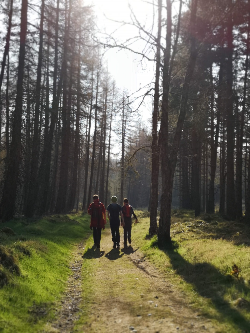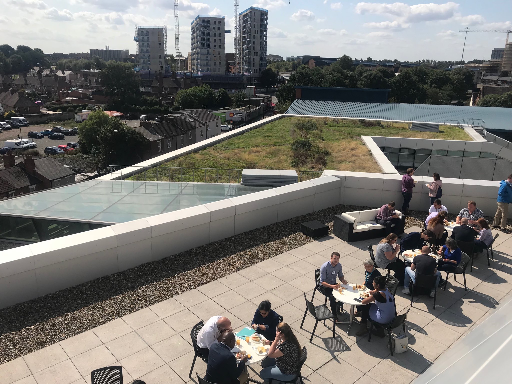This months blog comes from Dr Rebecca Wade. Senior Lecturer in Environmental Science at Abertay University. Rebecca talks about a new initiative around a Natural Health Service in Scotland:
The environment we live and work in has a fundamental impact on our health and wellbeing. Natural environments within our landscapes, including those that are managed, farmed and urban are important components of ‘healthy places’ with a role in promoting, maintaining and restoring good health, and preventing poor health.

Image 1. Get outdoors. It’s good for you! Greater use of the outdoors can contribute to improving public health, tackling health inequalities and improving wellbeing. Local Green Health Partnerships in Dundee, Lanarkshire, North Ayrshire and Highland are developing green health services which support people to engage with the natural environment and be more active more often outdoors. (Image Credit: R. Wade 2019)
In Scotland we recognise that the natural environment and associated green infrastructure is an important and undervalued asset for improving societal wellbeing and public health. Improvements in public health can be gained by increasing physical activity through green exercise - outdoor recreation, volunteering, play and learning, gardening and active travel. Wellbeing benefits can be gained through enhanced contact with good quality natural and green/blue spaces even without physical activity.
Our Natural Health Service (ONHS) action programme is a national initiative led by Scottish Natural Heritage (SNH), in partnership with a range of organisations from health, sport, transport, education and environment sectors. This programme is investigating how greater use of the outdoors can contribute to improving public health and tackling health inequalities. The project concept has been brewing for a while, it dates back to 2007 when SNH, Forestry Commission Scotland and NHS Health Scotland formed a Green Exercise Partnership to promote better health and quality of life for Scotland’s people by encouraging more physical activity outdoors and more contact with nature.
In 2018, four Local Green Health Partnerships were established in Dundee, Lanarkshire, North Ayrshire and Highland. These are the centre piece of the ONHS Action Programme. Each Partnership is co-ordinating cross-sectoral local action to promote nature as a resource for health and wellbeing. They are developing green health services which support people to engage with the natural environment and be more active more often outdoors in their communities. In Dundee the partnership is working with NHS Tayside to pilot ‘green prescriptions’. These are now offered by three GP surgeries in Dundee. This trial, launched in 2019, has been achieved by working across sectors, disciplines, and organisations. This ‘joined-up’ approach is essential if we want to gain multiple benefits for people and nature. By working together we can achieve benefits in relation to water management, biodiversity, pollution control, health, well-being, education and much more.
Ref: SNH. 2018. Our Natural Health Service in Scotland. http://www.naturalhealthservice.scot/






